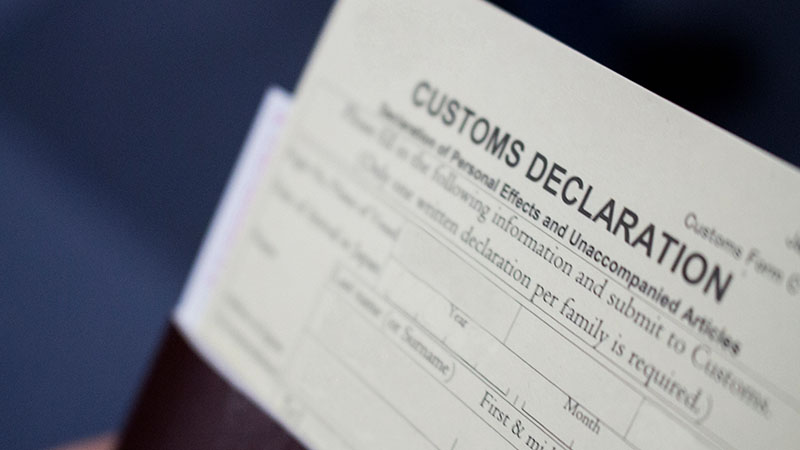Grow your business with the Discover newsletter
Logistics advice & insights straight to your inbox
Subscribe now
Over 748 million people call Europe home1. Across its 44 countries, the continent’s inhabitants span a wide range of socio-economic demographics, yet there is one commonality which should be of interest to ambitious online entrepreneurs: the rapid growth of e-commerce.
Fueled by rising internet penetration rates – and, of course, the pandemic – 2021 was a milestone year for e-commerce in Europe, with the number of online shoppers passing 500 million for the first time2. Now for the bit that should really interest you: cross-border e-commerce in Europe has risen to represent over 25% of the region’s total online sales3, as consumers increasingly look to foreign brands for new products and better prices.
In 2016, the Transatlantic Trade and Investment Partnership (TTIP), a proposed comprehensive trade deal between the European Union (EU) and the US to promote trade and economic growth, ended without an agreement. Despite this, the US and the EU remain robust trading partners, and account for a third of world trade3ii.
But, before you rush to put a big circle around Europe on your sales target map, there are some important things to consider.

There was a time when a “Made in the USA” stamp was a huge draw for global consumers. America as a manufacturer was associated with a high level of quality and innovation, the home of super brands like Apple and Nike. In the 2016 Nielsen Global Brand-Origin Survey4, nearly 75% of global consumers said a brand’s country of origin is as important or more important than several other purchasing drivers, including price, function, selection and quality.
However, in the interim years, there has been a significant shift in global consumers’ perception of the American brand. The country’s handling of the pandemic in particular, somewhat soured the relationship. In a Morning Consult survey5 of 5,000 European adults in five key markets (the UK, Germany, France, Spain and Italy), 40% said the country’s handling of the virus had made them less favorable towards American brands.
Whilst this may seem dire reading if you’re an American business wishing to tap into the European market, all is not lost. It’s a case of pivoting how you market yourself; leveraging other aspects of your brand beyond its American heritage. Knowing exactly why European consumers buy from US businesses in the first place is the key. In 2018, PayPal surveyed thousands of European shoppers about their main reasons for shopping from cross-border retailers:
Better prices (72% of respondents). Amidst economic pressures in a post-Covid world, consumers are increasingly open to switching brands and retailers to save money – presenting opportunities for competitively-priced US businesses to win their custom. Time to look at your price points and compare them to your main competitors.
Access to items not available in my country (49% of respondents). If you’re selling something which European consumers can’t source from domestic sellers, you’ll be cashing in – you just need to be sure they know you exist! Your business should be investing heavily in SEO and search to ensure it’s found. Also, look for gaps in the market in the country you intend to sell to – is there a way to pivot or adapt your products/service to meet the need?
I can discover new and interesting products (34% of respondents). Is your business selling something unique or niche? European consumers are curious and willing to try new things. Look at ways you could customize your products for the target country to give them extra appeal.
Source: PayPal Cross Border Research 20186
The biggest e-commerce markets in Europe are the UK, France and Germany7. These are what you might call “mature cross-border” markets; consumers there are used to shopping online and comfortable buying from overseas sellers. Yet, this doesn’t automatically mean they should be your first targets – it’s about finding the countries where the right customers for your business are:
A good strategy for your European expansion is to concentrate on just a few select markets first. You can then scale up and expand based on those with the best visible results.

Perhaps the most important thing to remember when plotting your European expansion is not to treat it like a single entity. Each country has its own language, cultural nuances and consumer shopping preferences. Your sales and marketing strategy should reflect these differences and be tailored for each European country you sell to if you are to truly maximize every sales opportunity.
DHL’s dedicated Country Guides have all the answers for you. Each free download has in-depth insights into e-commerce trends and statistics that will help you better understand the consumers in each country – and then tailor your sales strategy accordingly.
Another tip is to look at the most popular e-commerce websites in your destination country – particularly those selling products similar to your business. Look at how they market themselves to consumers, including the tone of voice across their website and social media channels. The more research you do, the more you’ll understand what appeals to consumers in that particular market.
Despite the differences highlighted in point 3., there are some preferences which European consumers do share when shopping online. Ensuring your e-commerce business is set up to meet these needs is the key to boosting your conversion rate, whichever European country you’re selling to.
Fast delivery
According to Sendcloud research9, 62% of European shoppers expect a delivery time of 2-3 days for goods bought from international sellers, whist the longest time they’re willing to wait is 4.4 days.
By partnering with an international logistics specialist like DHL, you can guarantee your cross-border customers fast and on-time delivery, with full tracking. Our international shipment services include a time-critical option which guarantees delivery before 9:00/10:30/12:00 on the next business day (available in select markets).
Free shipping
70% of European online shoppers said they are likely to add another product to their cart to reach a free shipping threshold. You will have to calculate whether the cost of offering free shipping is a worthwhile investment for the extra sales it generates for your business. You could trial it for a limited time in new markets to help you decide.
No hidden fees
Unexpected costs is one of the biggest reasons e-commerce customers abandon their carts. DHL’s Duty & Tax Calculator can be integrated into your e-commerce website to offer your shoppers the option to prepay all duties, taxes and fees at checkout for international purchases.
Returns
56% of European shoppers always check an online store’s returns policy before making a purchase. Ensure your policy is clearly stated on your e-commerce website, and if you can absorb the cost of making it free, it could help you win more sales.
Europe’s VAT de minimis removal
In mid-2021, the EU abolished the threshold at which EU e-commerce transactions became subject to EU VAT and a Customs Declaration. This means that all imports into EU countries – regardless of value – are now subject to VAT.
An Import One Stop Shop electronic portal has been introduced so non-EU businesses can register for VAT in the EU and the correct amount of VAT will make its way to the Member State to which it is due. This will simplify the process by enabling you to collect, declare and account for VAT and pay your bill directly to the EU Tax Authorities via a periodic tax return (for goods up to the value of €150).
For your customers, it means more price transparency: when they buy from a non-EU seller registered with the One Stop Shop, VAT will be part of the price they pay to the seller.
Our guide to Europe’s VAT de minimis removal has more information to guide you.

As an international logistics leader, our global network of dedicated Certified International Specialists have extensive experience with customs processes, guaranteeing faster clearance times for your shipments.
When shipping internationally with DHL, you will need to include some information about the shipment on the shipping label – commonly referred to as a waybill. Information typically included on a label:
Along with a shipping label, shipments may also need other documents such as a customs invoice or destination specific documents.
Whatever your business, and wherever you’re shipping to, we can help you reach new international markets with minimal hassle and maximum profit. Begin your journey here.
1 - Worldometer, March 2022
2 - Statista, published March 2022
3 - E-commerce News Europe, March 2021
3ii - Wikipedia, accessed March 2022
4 - Made in…which country?, Nielsen, 2016
5 - Morning Consult survey, 2020
6 - PayPal Cross Border Research 2018
7 - PaySpace Magazine, December 2020
8 - Ecommerce News Europe, August 2021
9 - Shift4ShopBlog, accessed March 2022